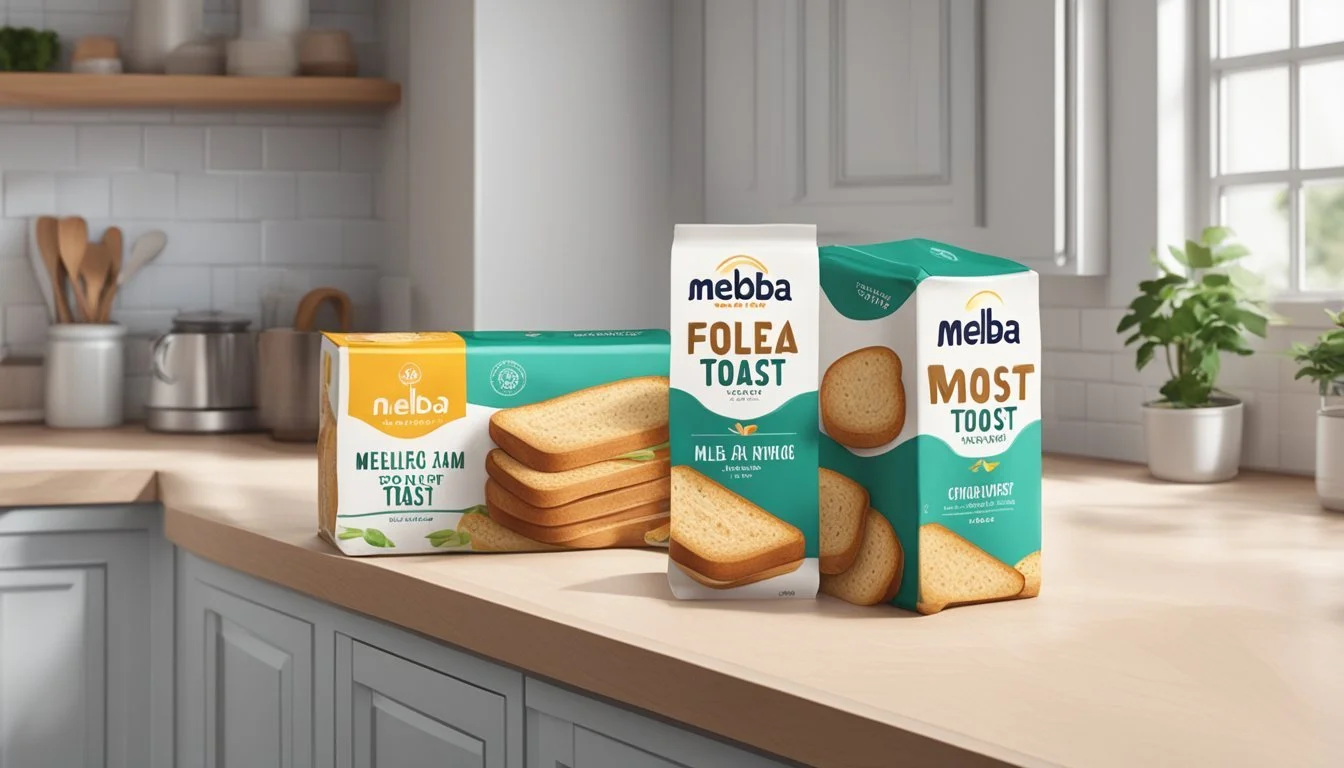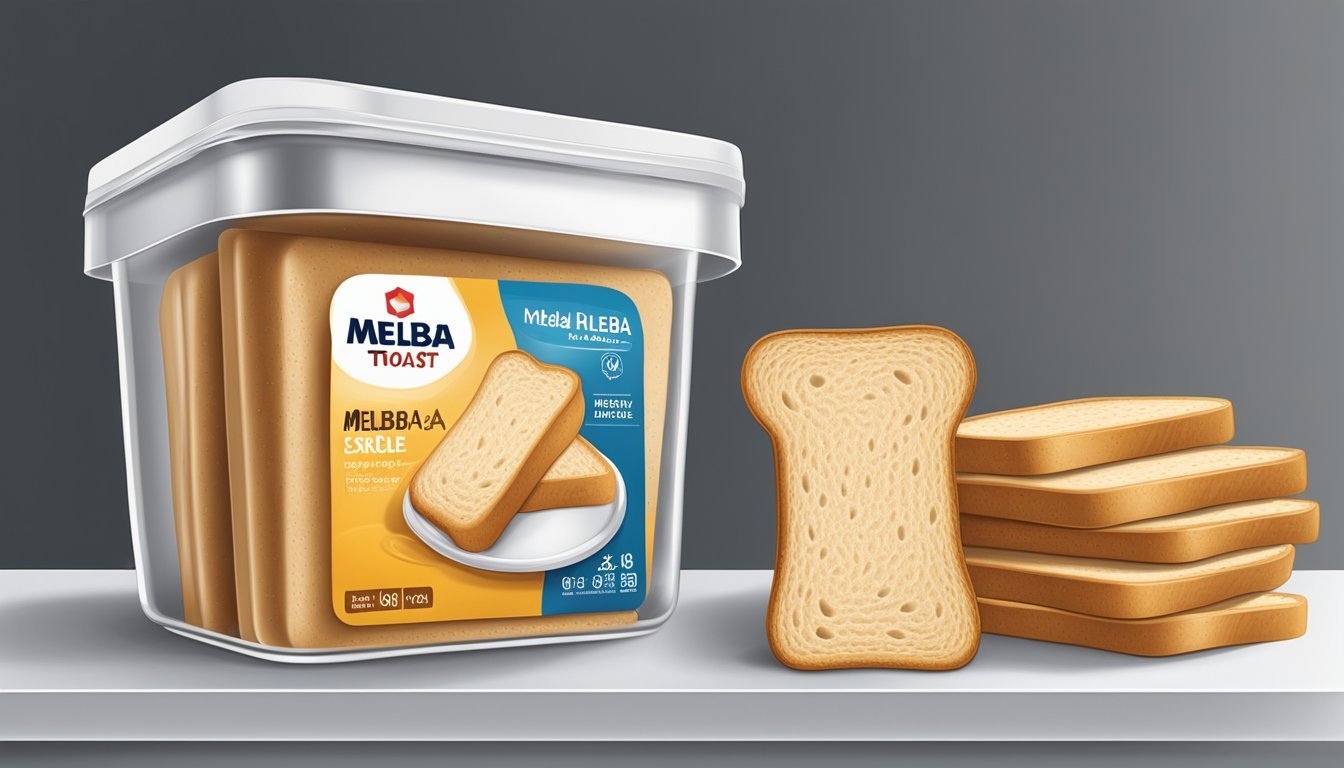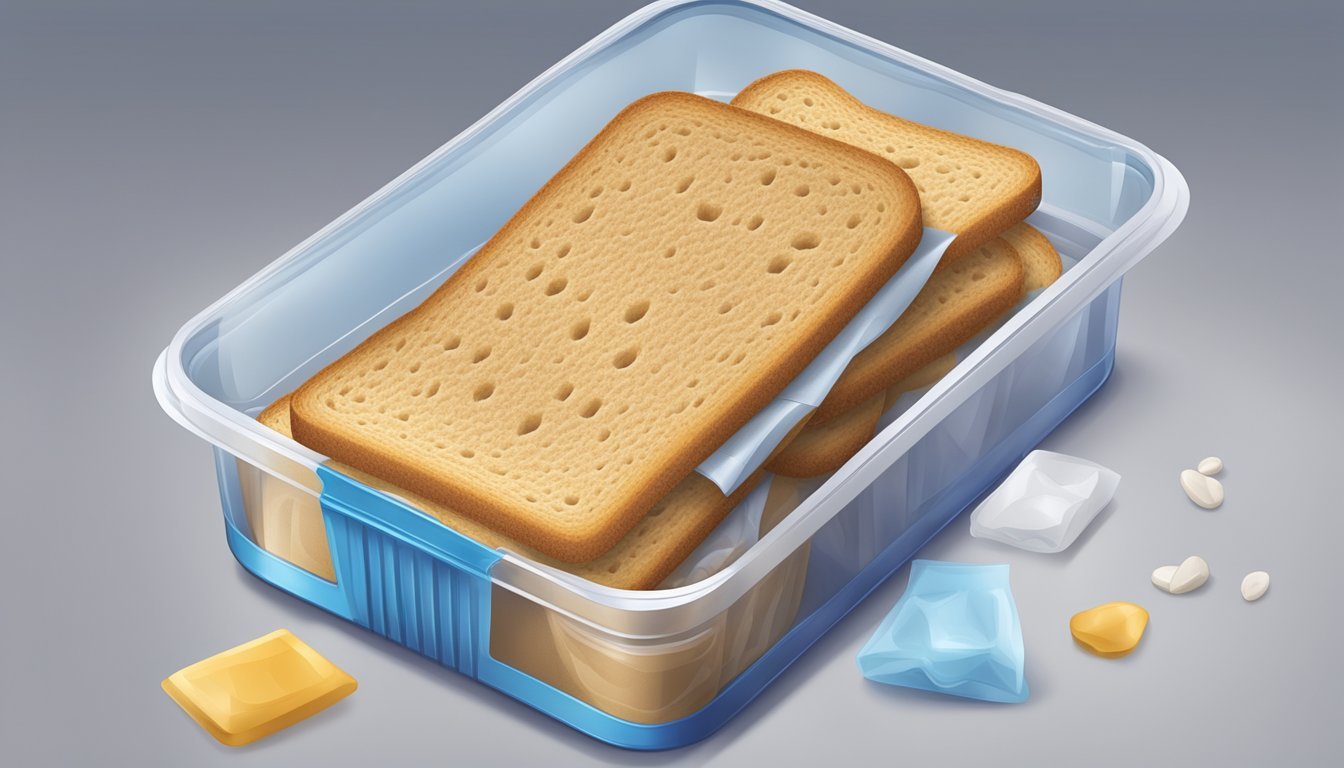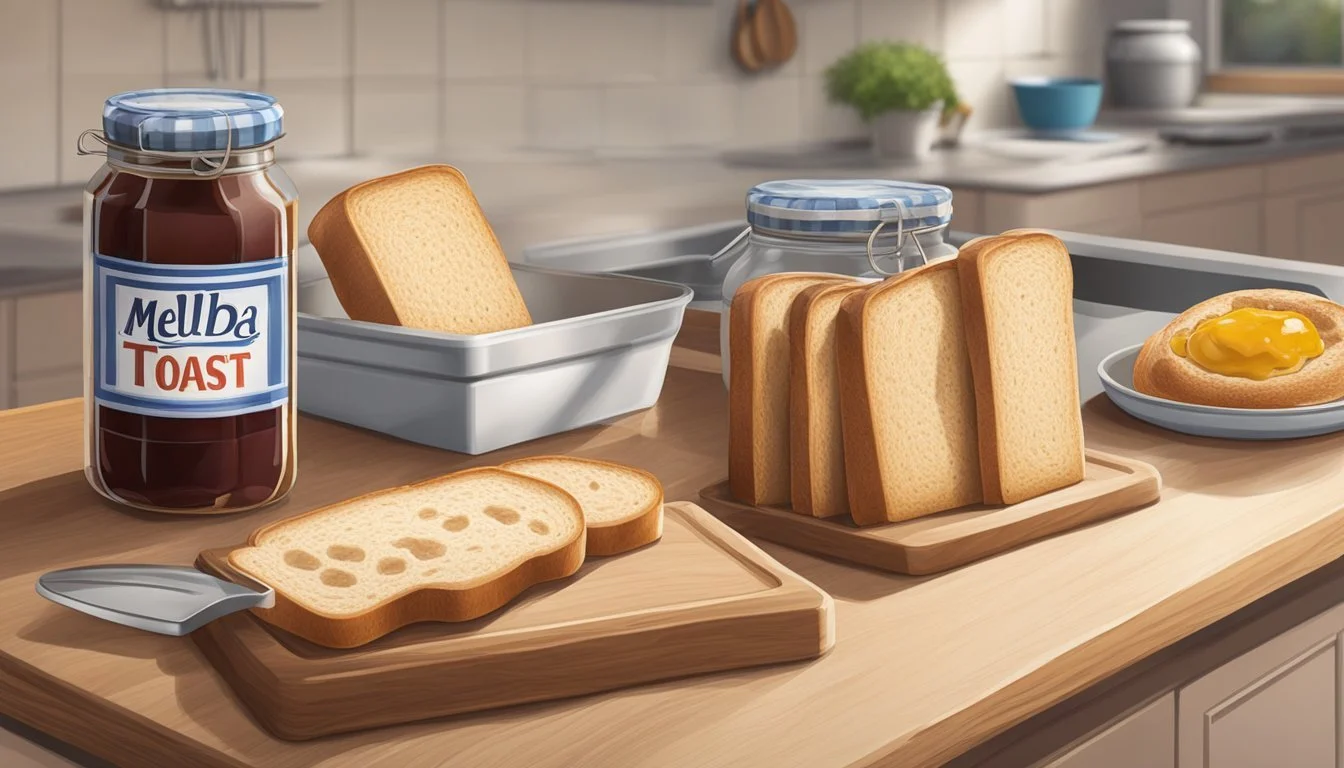How Long Does Melba Toast Last?
Unveiling Shelf Life & Storage Tips
Melba toast is known for its crisp texture and longevity, making it a pantry staple for many. Its shelf life surpasses that of regular bread (how long does bread last?) due to its reduced moisture content from double toasting, which inhibits the growth of mold and bacteria. When properly stored in an airtight container at room temperature, Melba toast can retain its quality and crispness.
The durability of Melba toast makes it an excellent choice for a consistent and reliable snack option. Generally, it can remain at peak quality for up to 3 days after opening. Despite this guideline, Melba toast often remains safe to consume beyond this period, although its texture, color, or flavor may change slightly over time. It is crucial for consumers to store Melba toast correctly to maximize its shelf life and maintain its characteristic crunch.
Overview of Melba Toast
Melba toast is a finely sliced, dry, and crisp bread often used as an accompaniment to soups and salads. This toast is baked to a golden brown with a distinctive crunch, making it a favorite for adding texture to a variety of dishes. The bread used for Melba toast typically is white, but variations can be made using sourdough or other types of bread.
Recipe and Baking: To create Melba toast, bread is thinly sliced and toasted until it becomes dry throughout. The process often involves double toasting—the bread is first toasted until lightly golden, then sliced thinly before being toasted again to achieve the desired crispness. Traditionally, crusts are removed to enhance texture and presentation.
Historical Roots: The creation of Melba toast is attributed to Auguste Escoffier, a renowned chef who named the snack after the Australian opera singer, Dame Nellie Melba. The invention coincides with a period when Dame Nellie Melba was recuperating from an illness, and the toast became a part of her diet.
Storage Tips: When stored properly in a cool, dry area and kept in a tightly sealed package, commercially packaged Melba toast can last up to a year without significant loss of quality. However, flavor, color, or texture may vary after the preferred shelf life. Home-baked Melba toast should be kept in an airtight container and can typically last for a few days at room temperature.
Melba toast can serve as a crispy base for toppings such as melted cheese or pâté, and its mild flavor allows it to complement a wide range of ingredients.
Storage Practices for Melba Toast
Proper storage of Melba toast ensures that its crispness and flavor are preserved. Melba toast should always be stored in an airtight container to prevent exposure to moisture and other environmental factors.
At Room Temperature
For optimum freshness, Melba toast should be kept in a cool, dry area. An unopened package of commercially packaged Melba toast can last for about 1 year without significant changes to its quality. Once opened, the remaining toast should be transferred to an airtight container. This prevents the Melba toast from becoming stale due to exposure to air.
Refrigeration
Refrigeration is typically not necessary for Melba toast, as room temperature is adequate to maintain its quality. If one chooses to refrigerate, it's crucial to store the toast in an airtight container to avoid condensation and subsequent softening of the toast.
Freezing
Freezing Melba toast is not recommended, as this can introduce moisture and alter the texture upon thawing. The Melba toast's signature crispness is best maintained at room temperature, in a suitable storage container that protects it from air and moisture.
Shelf Life Determination
Determining the shelf life of Melba toast involves considering factors such as storage conditions and packaging. Properly stored, Melba toast can retain its quality for an extended period.
Storage Environment:
The ideal storage condition for Melba toast is in a cool, dry area. Exposure to moisture or heat can accelerate staleness or potential spoilage.
Packaging:
Once opened, Melba toast should be kept in an airtight container to maintain its freshness. The original packaging might not be sufficient once the seal is broken, so transferring the toast to a container with a secure lid is advisable.
Shelf Life Expectancy:
Unopened package: Typically lasts for up to 1 year when stored properly.
Opened package: Best quality is maintained if consumed shortly after opening; however, an airtight container can extend its shelf life.
Quality Over Time:
With time, the texture, color, or flavor of Melba toast may change, but it generally remains safe to consume. The loss in quality is a sign that the toast is past its prime, and while it might not offer the best experience, it doesn't necessarily pose a health risk if stored correctly.
It’s important to inspect the Melba toast for any signs of spoilage, such as mold or off odors, before consumption, regardless of its age. If one observes any such signs, it's best to discard the product.
Signs of Spoilage
Melba toast can last a long time when stored properly, but like all food products, it is susceptible to spoilage. There are several indicators one should look for to determine if the toast has gone bad:
Color: Fresh Melba toast should maintain its original golden brown color. Any discoloration, such as dark spots or an overall change in hue, may indicate mold growth or staleness.
Mold: Any visible signs of mold, which can appear as fuzzy green, white, or black spots, mean the Melba toast is no longer safe to eat.
Texture: Melba toast should be crispy and dry. If it feels moist, soft, or chewy, this suggests that moisture has gotten into the packaging, increasing the risk of mold and spoilage.
Smell: An off or unusual odor is a clear indicator that the Melba toast should not be consumed. Fresh Melba toast will have a slightly toasted, bread-like smell without any sour or musty notes.
Taste: Although it is not recommended to taste food that shows other signs of spoilage, a stale or off taste can also signal that the Melba toast is past its best quality.
Consumers should regularly check their Melba toast for these signs of spoilage, especially if the package has been opened. It is advisable to discard any Melba toast that exhibits any of these characteristics to avoid the risk of foodborne illness.
Nutritional Information
Melba toast is a light, dry type of crisp bread. Here's a general overview of its nutritional content per serving.
Calories: It typically contains about 20 to 55 calories per piece. The exact calorie count may vary based on the brand and the size of the slice.
Total Fat: The total fat in Melba toast is usually low, ranging around 0.16g to 0.5g, making it a low-fat option for those monitoring their fat intake.
Saturated Fat: Saturated fat content is minimal, approximately 0.022g to 0.1g per serving, contributing insignificantly to the daily saturated fat limit.
Cholesterol: Generally, Melba toast contains no cholesterol, making it a suitable choice for heart-healthy diets.
Sodium: Depending on the brand, sodium levels might vary. It can range from 41mg to 85mg per serving, which requires consideration for those on sodium-restricted diets.
Carbohydrates: The carbohydrate content is relatively low, with about 3.83g to 11g per piece, making it a possible option for individuals controlling their carbohydrate consumption.
Sugars: An individual slice contains minimal sugar, typically less than 1 gram.
Protein: Protein levels are modest in Melba toast, often around 1.7g, contributing to daily protein needs.
Dietary Fiber: With a dietary fiber content ranging from 0.3g to 1.9g, Melba toast can contribute to the daily fiber intake.
Table 1: Nutritional Snapshot of Melba Toast
Nutrient Per serving (approximate) Calories 20 - 55 kcal Total Fat 0.16 - 0.5g Saturated Fat 0.022 - 0.1g Trans Fat N/A Cholesterol 0mg Sodium 41 - 85mg Carbohydrates 3.83 - 11g Dietary Fiber 0.3 - 1.9g Sugars <1g Protein ~1.7g
For those who monitor their diet, whether for weight management or medical reasons, understanding these nutritional details is crucial. Melba toast can be a suitable component of a balanced diet, especially due to its low-fat content and the presence of some dietary fiber.
Serving Suggestions and Pairings
Melba toast serves as a remarkably versatile food item, whether one seeks a light snack or an elegant side. Its crisp texture and mild flavor make it an ideal base for a plethora of toppings and pairings.
For a simple snack, one may choose to top it with butter or jam for a quick, satisfying treat. Alternatively, cream cheese (how long does cream cheese last?) offers a tanginess that complements the toast’s crunch, while hummus presents a healthy, flavorful option packed with protein.
When it comes to appetizers, Melba toast does not disappoint. It's an excellent carrier for pate or smoked salmon, creating a sophisticated and easy-to-prepare starter. The toast's sturdiness ensures it holds up well under these richer toppings.
A table outlining pairing options for Melba toast is as follows:
Type Suggestion Dairy Butter, Cream Cheese Spreads Hummus, Pate, Jam Protein Smoked Salmon, Chicken (shredded or sliced thin) Vegetables Avocado (in the form of slices or mashed as toast)
Should one require a side for their meal, Melba toast pairs excellently with soup, acting as a crunchy complement to the dish's liquid warmth. Additionally, its use extends to accompanying fish, where it can absorb flavors without being obtrusive.
Finally, Melba toast stands out as a carrier for a variety of dips, elevating it from a simple side to a dynamic part of any dining occasion. It can be enjoyed as-is or with a creative fusion of toppings, reinforcing its role as a versatile and charming addition to any gathering or meal.
Homemade Melba Toast Recipe
Creating homemade Melba toast is a simple process that involves thinly slicing bread, toasting it until crisp, and storing it properly. This allows the toast to maintain its desired crunchiness.
Ingredients and Preparation
Ingredients:
1 small loaf of sourdough bread (about 8 ounces)
Preparation:
Preheat the oven to 250 degrees Fahrenheit.
Slice the sourdough bread very thinly.
Cut the thinly sliced bread into smaller, bite-sized pieces.
Baking Process
Baking:
Place the bread slices on a baking sheet or baking tray, ensuring they do not overlap.
Toast the bread in the preheated oven, flipping the slices halfway through the baking process.
Allow to bake until the slices are dry, which typically takes about 2 hours.
Cooling and Storing Homemade Melba Toast
Cooling and Storage:
After baking, transfer the Melba toast to a cooling rack to allow it to cool evenly.
Once cool, store the Melba toast in an airtight container at room temperature.
Properly stored, homemade Melba toast can last up to 3 days while preserving its texture and taste.
Creative Uses for Melba Toast
Melba toast is a versatile pantry item with a crisp texture and subtle flavor that complements a variety of dishes and occasions. Here are some inventive ways to incorporate Melba toast into culinary creations:
As a Base for Appetizers:
Melba toast serves as a sturdy base for a range of appetizers, making it an excellent choice for parties. One can top it with a variety of spreads such as cheese, pâté, or hummus. Additionally, a layer of smoked meats (What wine goes well with smoked meats?) or pickles can create a delightful savory bite.
Breadcrumb Substitute:
When ground, Melba toast transforms into fine breadcrumbs that can coat foods or be mixed into stuffings. It is an ample substitute for panko and can be used to bread chicken, fish, or vegetables, offering a lighter, crunchier texture.
Enhancing Pasta Dishes:
Crumbled Melba toast can be added to pasta for a crunchy topping. It pairs exquisitely with pasta dishes such as Creamy Baked Macaroni and Cheese or can be combined with garlic and herbs to elevate a simple pasta with olive oil.
Salad Topping:
Instead of traditional croutons (how long do croutons last?), Melba toast can be broken into small pieces and scattered over salads. This substitution adds a satisfying crunch without overpowering the fresh taste of the salad.
Quick Snack Option:
For a speedy snack, Melba toast can be enjoyed on its own or with a thin slice of cheese or a smear of preserves. It's an easy substitute for crackers when a light, crisp texture is desired.
These applications of Melba toast ensure it is not just a simple snack but an ingredient that can enhance a variety of dishes with its crunchy texture and ability to pair with diverse flavors.
Health and Dietary Considerations
Melba toast is often considered for various dietary plans due to its nutritional profile. Typically, a piece of Melba toast contains about 20 calories, which can easily fit into a low-calorie diet. For those monitoring fat intake, Melba toast is low in total fat, with approximately 0.16 grams per piece, and it contains a minimal amount of saturated fat, at approximately 0.022 grams.
Cholesterol is a non-issue with Melba toast, as it contains 0mg per serving, making it a heart-friendly option. In terms of sodium, each piece generally has around 41mg, which is about 2% of the daily recommended intake, so it can be consumed in moderation even in a low-sodium diet.
The carbohydrates in Melba toast tally up to roughly 3.83 grams, with a very low sugar content of 0.05 grams per piece, making it appropriate for those on a low-sugar or diabetic diet. Moreover, it provides a modest amount of dietary fiber, around 0.3 grams.
Individuals watching their protein intake will find Melba toast offering a small contribution to their daily protein needs.
Here is a simplified nutritional table for a standard serving size of one piece of Melba toast:
Nutrient Amount Calories 20 Total Fat 0.16g Saturated Fat 0.022g Cholesterol 0mg Sodium 41mg Carbohydrates 3.83g Dietary Fiber 0.3g Sugars 0.05g Protein —
In conclusion, Melba toast is suitable for various restricted diets, such as low-calorie, low-carb, Keto, Kosher, or diabetic diet plans. Its inclusion as a food choice should be balanced with other sources of protein and nutrients to support overall health.
History and Origin of Melba Toast
Melba toast derives its name from Dame Nellie Melba, an accomplished Australian opera singer. This crispy bread accompaniment was the creation of Auguste Escoffier, who at the time was the head chef at London's Savoy Hotel. The toast is well-known for its unique texture and golden brown color that offers a crunchy experience compared to regular bread.
The connection between Escoffier and Melba extends beyond the toast, as Escoffier also created the renowned dessert, Peach Melba, in honor of the singer. The inception of Melba toast is a story of innovation in the kitchen. Escoffier, seeking to provide a delicate toast for the dieting Dame Melba, thinly sliced stale bread before retoasting it to achieve its distinctive crunchiness.
Historical accounts suggest that initially, Melba toast may have been referred to as "Toast Marie," after the wife of César Ritz, the hotel manager. Yet, it is the connection to Dame Nellie Melba that has stood the test of time, solidifying the toast's place in culinary history.
The toast's popularity was further boosted in the 1920s when it became associated with dieting and health, namely through its inclusion in the "Eighteen Day Reducing Diet" prescribed by the Mayo Brothers, which reportedly contributed to its widespread consumption during that period.
Functionally, Melba toast provided a practical use for stale bread, transforming it into a desirable food item. Its shelf life, when stored properly, can extend significantly past that of regular bread due to its reduced moisture content.
Tips for Keeping Melba Toast Crispy
Proper storage is key to maintaining the crunchiness of Melba toast. Exposure to moisture is the enemy, as it softens the toast, which is intended to be enjoyed with its signature crisp texture. Here are some effective methods for keeping Melba toast crispy:
Airtight Containers: It’s imperative to store Melba toast in airtight containers. This prevents air and moisture from compromising the texture. Metal tins with secure lids or plastic storage containers with tight seals work well.
Container Type Advantage Metal Tins Durable and often more airtight. Plastic Containers Lightweight and usually have a snap-on lid.
Room Temperature Storage: Keep the airtight container at room temperature in a dry area of your kitchen. Avoid storing near stoves or sinks where steam or heat could encourage moisture buildup.
Re-Crisping Method: If the Melba toast starts to lose its crispness, one can lightly toast it in the oven at a low temperature, around 250°F for a few minutes, to revitalize its crunch. However, be cautious not to over-toast.
Monitor Freshness: While Melba toast can last a long time when stored properly, check for changes in texture, color, or flavor over time. Although it may still be safe to eat after the best quality date, the desirability of its texture might change.
By following these straightforward steps, consumers can enjoy the crunchy pleasure of Melba toast anytime, preserving its delightful crunch until the last piece.
Frequently Asked Questions
In exploring the nuances of preserving and enjoying Melba toast, there are several common queries. This section aims to address these succinctly, providing practical insight into the longevity, versatility, and dietary compatibility of this crunchy snack.
Can Melba Toast be revitalized once it becomes soft?
To restore crispness to Melba toast that has become soft, one can re-toast it briefly at a low temperature until it regains the desired crunchy texture. This reheating process should be monitored closely to prevent burning.
What are the best toppings for Melba Toast?
The best toppings for Melba Toast can range from simple butter or cheese to more elaborate pâté or canapés, showcasing its versatility. The toast's firmness supports a variety of toppings that enhance its flavor without compromising its structural integrity.
Savory: Cream cheese, smoked salmon, avocado
Sweet: Fruit preserves, honey, Nutella
Is Melba Toast suitable for all diets?
Melba Toast is generally suitable for many diets due to its simple ingredients—typically just bread that has been thinly sliced and toasted until it becomes dry and crisp. However, it may not be appropriate for gluten-free diets unless made from gluten-free bread. Additionally, its low calorie and low fat qualities make it a favorite for those watching their caloric intake.
Conclusion
Melba toast can be a practical choice for those seeking a durable pantry item. Proper storage is key to maximize its shelf life, ensuring that it remains a crispy and enjoyable snack beyond its best before date.
Shelf Life Expectations:
Unopened Package: When kept in a cool, dry area, commercially packaged Melba toast typically lasts up to 1 year without significant degradation in quality.
Opened Package: Once opened, maintaining the toast's crispiness relies on how it is stored. Keeping the package tightly sealed can prolong its quality.
Storage Practices:
Cool, Dry Area: Vital to deter spoilage and maintain quality.
Sealed Container: Necessary post-opening to prevent moisture and contaminants.
Quality Over Time:
Texture, Color, and Flavor: These attributes may alter slightly after the peak quality period, but the toast is generally still safe to consume if there have been no breaches in storage protocol.
In preference to sustenance safety, an inspection for signs of spoilage is advised before consumption, especially if the toast has been stored for an extensive period. In the unlikely event of mold or an off-putting smell, the toast should be discarded.
In summary, Melba toast's longevity hinges on adherence to recommended storage methods. They play a pivotal role in ensuring Melba toast remains a reliable and ready-to-eat option in the kitchen.














